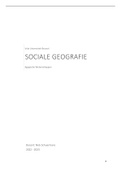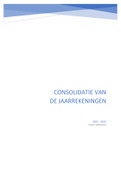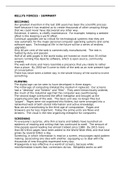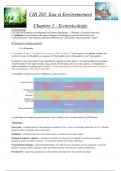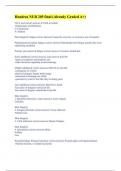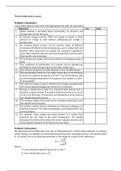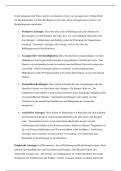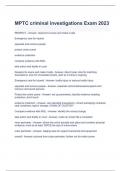Vrije Universiteit Brussel
SOCIALE GEOGRAFIE
Agogische Wetenschappen
Docent: Nick Schuermans
2022 - 2023
0
,INHOUD
0. Algemene informatie....................................................................................................................... 5
1. Inleiding ........................................................................................................................................... 6
1.1 Een definitie............................................................................................................................. 6
1.2 Het wetenschappelijke (grafie) ............................................................................................... 6
1.3 Het sociale ............................................................................................................................... 7
1.3.1 Productiewijzen ............................................................................................................... 7
1.3.2 Economische integratiewijzen......................................................................................... 9
1.4 Het ruimtelijke (Geo) ............................................................................................................. 11
1.4.1 Territorium – Schaal – Plaats – Netwerk (TSPN) ........................................................... 11
1.4.2 De ruimtelijke dimensie van economische integratiesferen ......................................... 12
2. De sociale geografie van de feodale samenleving ........................................................................ 13
2.1 Sociale structuur en economische integratie tijdens de Europese feodaliteit ..................... 13
2.1.1 De sociale structuur: onvrijen, vrijen en edelen ........................................................... 13
2.1.2 Bezitstructuren, herverdeling en vermarkting op het platteland ................................. 15
2.1.3 Groeiend belang marktruil & opkomst van steden tijdens de Laat-Feodale periode ... 16
2.2 De relatie tussen bevolkingsdruk en ruimte........................................................................... 18
2.3 De Middeleeuwse ontginningsgolven In het Graafschap Vlaanderen................................... 19
2.4 De ruimtelijke organisatielogica van evoluerende landbouwbedrijftypes ............................. 21
2.4.1 Veldkruidbedrijf ............................................................................................................. 21
2.4.2 Mestbedrijf .................................................................................................................... 22
2.4.3 Drieslagstelsel ................................................................................................................ 24
2.4.4 Het driesbedrijf .............................................................................................................. 24
2.4.5 Het euselbedrijf ............................................................................................................. 24
3. Sociale geografie van het opkomend kapitalisme......................................................................... 25
3.1 Fundamentele veranderingsprocessen ................................................................................. 25
3.2 De markt als motor van economische en geografische dynamiek ....................................... 26
3.2.1 Markt en plan ................................................................................................................. 26
3.2.2 (On)evenwicht tussen vraag en aanbod ........................................................................ 27
3.2.3 Marktstrategieën – Hoe word je een winnaar? ............................................................ 27
3.2.4 Accumulatieregimes ...................................................................................................... 28
3.3 Handelskapitalisme 1500-1770 ............................................................................................. 29
3.3.1 Opkomst van het handelskapitalisme ........................................................................... 29
3.3.2 Waarom kapitalisme eerst in Verenigd Koninkrijk? (16de - 17de eeuw)...................... 29
1
, 3.4 Industrieel kapitalisme vanaf 1770 (begin Kondratiev I)....................................................... 30
3.4.1 Start in Engeland rond 1750 .......................................................................................... 30
3.4.2 Industrieel kapitalisme in België ................................................................................... 30
3.5 Verstedelijking ....................................................................................................................... 31
3.6 Kondratievgolven .................................................................................................................. 32
4. Sociale geografie van het kapitalisme ........................................................................................... 34
4.1 Kondratievgolven .................................................................................................................. 34
4.1.1 Kondratiev I: de stoommachine (1770 – 1840) ............................................................. 34
4.1.2 Kondratiev II: Spoorwegen en staal (1840 – 1890) ....................................................... 35
4.1.3 Kondratiev III (1880 – 1930): Anti-grootstedelijkheid tijdens de IR .............................. 35
4.1.4 Kondratiev IV (1930-1970) fordistisch accumulatieregime ........................................... 38
4.1.5 Kondratiev V (1970-2010): post-fordistisch accumulatieregime .................................. 40
4.2 De Centrale Plaatsen Theorie – Model van Christaller (1929)................................................ 42
4.3 De ruimtelijke vorm van verstedelijking in Vlaanderen ........................................................ 44
4.3.1 Het Belgische stedennet ................................................................................................ 44
4.3.2 Stadsgewesten............................................................................................................... 44
5. Geologische metafoor ................................................................................................................... 46
5.1 Het Begrip ‘geologische metafoor’ ........................................................................................ 46
5.2 De historische ontwikkeling van metropolitane kerngebieden in België .............................. 47
5.3 Economische ontwikkelingen België ..................................................................................... 48
5.4 Waarom vestigen tech-bedrijven zich in Sillicon Valley? ...................................................... 49
6. Bevolkingsgeografie ...................................................................................................................... 50
6.1 Op globale schaal................................................................................................................... 50
6.1.1 Bevolkingsgroei ............................................................................................................. 50
6.1.2 Demografische transitie ................................................................................................ 52
6.1.3 Migratie ......................................................................................................................... 53
6.2 Op Belgische schaal ............................................................................................................... 54
6.2.1 Bevolkingsgroei ............................................................................................................. 54
6.2.2 Migratie & superdiversiteit ........................................................................................... 55
7. De geografie van het overleven .................................................................................................... 57
7.1 Definities................................................................................................................................ 57
7.1.1 Overlevingsstrategieën .................................................................................................. 57
7.1.2 Economische integratiesferen ....................................................................................... 57
7.1.3 Integratief vs uitsluitend ............................................................................................... 58
2
, 7.1.4 De geografische dimensie ............................................................................................. 59
7.2 Context .................................................................................................................................. 59
7.3 Case-studies........................................................................................................................... 60
7.4 Geografie van het overleven ................................................................................................. 60
7.4.1 Methodologie ................................................................................................................ 60
7.4.2 Bevindingen ................................................................................................................... 60
7.4.3 Discussie ........................................................................................................................ 61
8. Aankomstwijken ............................................................................................................................ 62
8.1 De stedelijke transitiezone .................................................................................................... 62
8.2 Case studies: Antwerpen-Noord & Liedekerke ..................................................................... 63
8.3 Beleid: sociale mix? ............................................................................................................... 63
8.3.1 Hypothese ..................................................................................................................... 63
8.3.2 Laatste twintig jaar: revanchistische gentrificatie? ....................................................... 63
8.3.3 Motieven al dan niet voor sociale mix .......................................................................... 64
8.3.4 Haalbaarheid sociale mix ............................................................................................... 64
9. Geschiedenis van de sociale geografie .......................................................................................... 65
9.1 Maatschappelijke tendensen 19e eeuw ................................................................................ 65
9.2 Traditionele opvattingen ....................................................................................................... 66
9.2.1 Fysisch determinisme .................................................................................................... 66
9.2.2 Culturele geografie ........................................................................................................ 67
9.2.3 Possibilisme ................................................................................................................... 67
9.3 Maatschappelijke tendensen na WOII .................................................................................. 67
9.4 Naoorlogse visies ................................................................................................................... 68
9.4.1 Spatial analysts: Ruimtelijke analyse ............................................................................. 68
9.4.2 Behaviorale geografie: gedrag....................................................................................... 68
9.4.3 Humanistische geografie: percepties ............................................................................ 68
9.4.4 Marxistische geografie: radicaal op Marx geïnspireerde onderzoeken ........................ 69
9.4.5 Feministische geografie ................................................................................................. 69
9.4.6 Postmoderne geografie: na 1990 .................................................................................. 69
9.5 Besluit .................................................................................................................................... 69
10. Examenvragen ........................................................................................................................... 70
10.1 Les 1: inleidig ......................................................................................................................... 70
10.2 Les 2: De sociale geografie van de feodale samenleving ...................................................... 70
10.3 Les 3: De sociale geografie van de opkomst van het kapitalisme ......................................... 71
3
SOCIALE GEOGRAFIE
Agogische Wetenschappen
Docent: Nick Schuermans
2022 - 2023
0
,INHOUD
0. Algemene informatie....................................................................................................................... 5
1. Inleiding ........................................................................................................................................... 6
1.1 Een definitie............................................................................................................................. 6
1.2 Het wetenschappelijke (grafie) ............................................................................................... 6
1.3 Het sociale ............................................................................................................................... 7
1.3.1 Productiewijzen ............................................................................................................... 7
1.3.2 Economische integratiewijzen......................................................................................... 9
1.4 Het ruimtelijke (Geo) ............................................................................................................. 11
1.4.1 Territorium – Schaal – Plaats – Netwerk (TSPN) ........................................................... 11
1.4.2 De ruimtelijke dimensie van economische integratiesferen ......................................... 12
2. De sociale geografie van de feodale samenleving ........................................................................ 13
2.1 Sociale structuur en economische integratie tijdens de Europese feodaliteit ..................... 13
2.1.1 De sociale structuur: onvrijen, vrijen en edelen ........................................................... 13
2.1.2 Bezitstructuren, herverdeling en vermarkting op het platteland ................................. 15
2.1.3 Groeiend belang marktruil & opkomst van steden tijdens de Laat-Feodale periode ... 16
2.2 De relatie tussen bevolkingsdruk en ruimte........................................................................... 18
2.3 De Middeleeuwse ontginningsgolven In het Graafschap Vlaanderen................................... 19
2.4 De ruimtelijke organisatielogica van evoluerende landbouwbedrijftypes ............................. 21
2.4.1 Veldkruidbedrijf ............................................................................................................. 21
2.4.2 Mestbedrijf .................................................................................................................... 22
2.4.3 Drieslagstelsel ................................................................................................................ 24
2.4.4 Het driesbedrijf .............................................................................................................. 24
2.4.5 Het euselbedrijf ............................................................................................................. 24
3. Sociale geografie van het opkomend kapitalisme......................................................................... 25
3.1 Fundamentele veranderingsprocessen ................................................................................. 25
3.2 De markt als motor van economische en geografische dynamiek ....................................... 26
3.2.1 Markt en plan ................................................................................................................. 26
3.2.2 (On)evenwicht tussen vraag en aanbod ........................................................................ 27
3.2.3 Marktstrategieën – Hoe word je een winnaar? ............................................................ 27
3.2.4 Accumulatieregimes ...................................................................................................... 28
3.3 Handelskapitalisme 1500-1770 ............................................................................................. 29
3.3.1 Opkomst van het handelskapitalisme ........................................................................... 29
3.3.2 Waarom kapitalisme eerst in Verenigd Koninkrijk? (16de - 17de eeuw)...................... 29
1
, 3.4 Industrieel kapitalisme vanaf 1770 (begin Kondratiev I)....................................................... 30
3.4.1 Start in Engeland rond 1750 .......................................................................................... 30
3.4.2 Industrieel kapitalisme in België ................................................................................... 30
3.5 Verstedelijking ....................................................................................................................... 31
3.6 Kondratievgolven .................................................................................................................. 32
4. Sociale geografie van het kapitalisme ........................................................................................... 34
4.1 Kondratievgolven .................................................................................................................. 34
4.1.1 Kondratiev I: de stoommachine (1770 – 1840) ............................................................. 34
4.1.2 Kondratiev II: Spoorwegen en staal (1840 – 1890) ....................................................... 35
4.1.3 Kondratiev III (1880 – 1930): Anti-grootstedelijkheid tijdens de IR .............................. 35
4.1.4 Kondratiev IV (1930-1970) fordistisch accumulatieregime ........................................... 38
4.1.5 Kondratiev V (1970-2010): post-fordistisch accumulatieregime .................................. 40
4.2 De Centrale Plaatsen Theorie – Model van Christaller (1929)................................................ 42
4.3 De ruimtelijke vorm van verstedelijking in Vlaanderen ........................................................ 44
4.3.1 Het Belgische stedennet ................................................................................................ 44
4.3.2 Stadsgewesten............................................................................................................... 44
5. Geologische metafoor ................................................................................................................... 46
5.1 Het Begrip ‘geologische metafoor’ ........................................................................................ 46
5.2 De historische ontwikkeling van metropolitane kerngebieden in België .............................. 47
5.3 Economische ontwikkelingen België ..................................................................................... 48
5.4 Waarom vestigen tech-bedrijven zich in Sillicon Valley? ...................................................... 49
6. Bevolkingsgeografie ...................................................................................................................... 50
6.1 Op globale schaal................................................................................................................... 50
6.1.1 Bevolkingsgroei ............................................................................................................. 50
6.1.2 Demografische transitie ................................................................................................ 52
6.1.3 Migratie ......................................................................................................................... 53
6.2 Op Belgische schaal ............................................................................................................... 54
6.2.1 Bevolkingsgroei ............................................................................................................. 54
6.2.2 Migratie & superdiversiteit ........................................................................................... 55
7. De geografie van het overleven .................................................................................................... 57
7.1 Definities................................................................................................................................ 57
7.1.1 Overlevingsstrategieën .................................................................................................. 57
7.1.2 Economische integratiesferen ....................................................................................... 57
7.1.3 Integratief vs uitsluitend ............................................................................................... 58
2
, 7.1.4 De geografische dimensie ............................................................................................. 59
7.2 Context .................................................................................................................................. 59
7.3 Case-studies........................................................................................................................... 60
7.4 Geografie van het overleven ................................................................................................. 60
7.4.1 Methodologie ................................................................................................................ 60
7.4.2 Bevindingen ................................................................................................................... 60
7.4.3 Discussie ........................................................................................................................ 61
8. Aankomstwijken ............................................................................................................................ 62
8.1 De stedelijke transitiezone .................................................................................................... 62
8.2 Case studies: Antwerpen-Noord & Liedekerke ..................................................................... 63
8.3 Beleid: sociale mix? ............................................................................................................... 63
8.3.1 Hypothese ..................................................................................................................... 63
8.3.2 Laatste twintig jaar: revanchistische gentrificatie? ....................................................... 63
8.3.3 Motieven al dan niet voor sociale mix .......................................................................... 64
8.3.4 Haalbaarheid sociale mix ............................................................................................... 64
9. Geschiedenis van de sociale geografie .......................................................................................... 65
9.1 Maatschappelijke tendensen 19e eeuw ................................................................................ 65
9.2 Traditionele opvattingen ....................................................................................................... 66
9.2.1 Fysisch determinisme .................................................................................................... 66
9.2.2 Culturele geografie ........................................................................................................ 67
9.2.3 Possibilisme ................................................................................................................... 67
9.3 Maatschappelijke tendensen na WOII .................................................................................. 67
9.4 Naoorlogse visies ................................................................................................................... 68
9.4.1 Spatial analysts: Ruimtelijke analyse ............................................................................. 68
9.4.2 Behaviorale geografie: gedrag....................................................................................... 68
9.4.3 Humanistische geografie: percepties ............................................................................ 68
9.4.4 Marxistische geografie: radicaal op Marx geïnspireerde onderzoeken ........................ 69
9.4.5 Feministische geografie ................................................................................................. 69
9.4.6 Postmoderne geografie: na 1990 .................................................................................. 69
9.5 Besluit .................................................................................................................................... 69
10. Examenvragen ........................................................................................................................... 70
10.1 Les 1: inleidig ......................................................................................................................... 70
10.2 Les 2: De sociale geografie van de feodale samenleving ...................................................... 70
10.3 Les 3: De sociale geografie van de opkomst van het kapitalisme ......................................... 71
3

